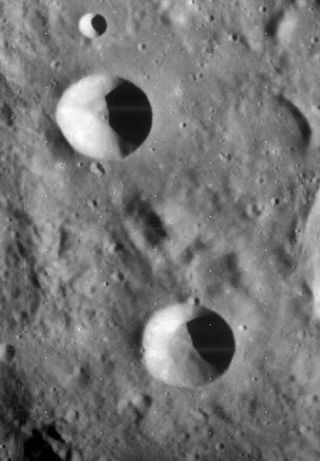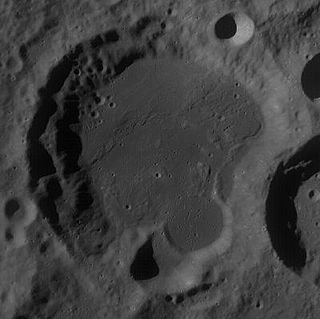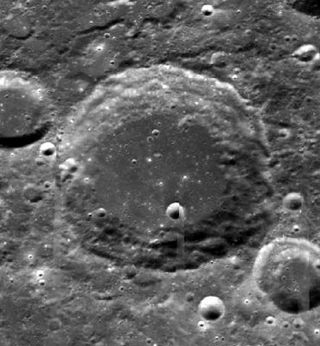
Plato is a lava-filled lunar impact crater on the Moon. Its diameter is 101 km. It was named after ancient Greek philosopher Plato. It is located on the northeastern shore of the Mare Imbrium, at the western extremity of the Montes Alpes mountain range. In the mare to the south are several rises collectively named the Montes Teneriffe. To the north lies the wide stretch of the Mare Frigoris. East of the crater, among the Montes Alpes, are several rilles collectively named the Rimae Plato.

Deslandres is the heavily worn and distorted remains of a lunar impact crater. It is located to the southeast of the Mare Nubium, in the rugged southern highlands of the Moon. In dimension it is the third-largest crater formation on the visible Moon, being beaten only by Clavius and by the 303-kilometer-diameter walled plain Bailly. The northern and eastern parts of the floor display a relatively level surface, but it is pock-marked with numerous craters. There is a small region of mare material, due to basaltic lava, along the eastern interior floor.

Delambre is a lunar impact crater that lies to the southwest of Mare Tranquillitatis, in the central highland region. To the west is the crater pair of Theon Junior and Theon Senior, the latter being more distant and located to the northwest.

Geber is a lunar impact crater that is located in the rugged south-central highlands of the Moon. It lies halfway between the crater Almanon to the north-northeast and the crater pair of Azophi and Abenezra to the south-southwest. Farther to the southeast is Sacrobosco. Geber is 45 kilometers in diameter and 3,510 meters deep.

Donati is a lunar impact crater that is located in the rugged south-central highlands of the Moon. It lies just to the northwest of the crater Faye, and the two outer rims are separated by a gap of less than 10 kilometers. To the north is the comparably sized Airy, and farther to the southeast is Playfair. Donati is 36 kilometers in diameter.

Theon Junior is a lunar impact crater that is located just to the west-southwest of the crater Delambre. It forms a matching pair with Theon Senior, only a couple of crater diameters to the north-northwest. The crater is circular and bowl-shaped, with a small floor at the bottom of the high, sloping interior walls. It is named for Theon of Alexandria, a 4th-century Greek astronomer and mathematician. The crater is from the Eratosthenian period, which lasted from 3.2 to 1.1 billion years ago. It is 17 kilometers in diameter and the difference in height at its rim and its deepest part is 3,580 meters.

Cepheus is a lunar impact crater that is located in the northeastern part of the Moon, within one crater diameter of the larger crater Franklin to the southeast. To the north-north-east is the flooded crater Oersted. The proximity of this formation to the lunar limb means it appears oblong when viewed from the Earth due to foreshortening.

Deluc is a lunar impact crater that lies in the southern highlands of the Moon. It is located to the south-southeast of the crater Maginus, and the huge Clavius. Due east of Deluc is the somewhat larger crater Lilius. It is 47 kilometers in diameter and 3.3 kilometers deep. It is from the Pre-Imbrian period, which lasted from 4.55 to 3.85 billion years ago.

Curtius is a lunar impact crater that is located in the southern part of the Moon. From the Earth the crater appears foreshortened, making it more difficult to observe detail. Nevertheless, this is a large crater that can be readily found in even small telescopes. Curtius is located within one crater diameter of the still-larger Moretus to the southwest. To the northeast is the smaller Pentland. Curtius is 95 kilometers in diameter and 6.8 kilometers deep. It is from the Nectarian period, 3.92 to 3.85 billion years ago.

Buffon is a lunar impact crater that is located on the southern hemisphere on the far side of the Moon. It lies a crater diameter south of the large walled plain Chebyshev. To the northeast is the crater Langmuir and to the southwest is Leavitt. Buffon lies nearly at the midpoint between these formations.

Hell is a lunar crater in the south of the Moon's near side, within the western half of the enormous walled plain Deslandres. To the southeast, also within Deslandres, is the larger crater Lexell, and about 9° to the south lies the prominent Tycho crater. The crater received its name in 1935 after the Hungarian astronomer and ordained Jesuit priest Maximilian Hell. It has 19 satellite craters with diameters ranging between about 3 and 22 km. Nearly all Hell craters are relatively flat and shallow, with a sharp, well-defined rim and a typical diameter-to-depth ratio of about 10.

Darwin is a lunar impact crater of the type categorised as a walled plain. It lies in the southeastern part of the Moon, and is sufficiently close to the limb to appear significantly foreshortened when viewed from the Earth. Attached to its southern rim is Lamarck. To the northeast is the dark-floored crater Crüger.

Carver is a lunar impact crater that is located on the far side of the Moon, due east of the walled plain Van der Waals. To the northeast is the crater Rosseland, and to the south-southeast lies Kozyrev.

Crocco is a lunar impact crater that is located on the far side of the Moon from the Earth. It is located to the northeast of the huge walled plain Planck, and northwest of the equally huge Poincaré. Just to the north, within one crater diameter, is the crater Koch.

Coriolis is a lunar impact crater that is located on the far side of the Moon. The crater floor is bisected by the lunar equator, and it lies about three crater diameters northwest of the crater Daedalus.

Coulomb is a lunar impact crater that lies behind the northwestern limb, on the far side of the Moon. It is located to the west-southwest of the large crater Poczobutt, and northeast of Sarton.

Pontanus is a lunar impact crater that is located in the southern highlands of the Moon's near side. It lies approximately midway between the craters Sacrobosco to the north-northeast and Gemma Frisius to the south-southwest. It is 58 kilometers in diameter and 2,120 meters deep.

Epimenides is a lunar impact crater that is located in the southwestern part of the Moon's near side, just to the east of the oddly shaped crater Hainzel. Just to the north and northeast is Lacus Timoris, a small lunar mare. The crater is 27 kilometers in diameter and 2,000 meters deep. It may be from the Pre-Nectarian period, 4.55 to 3.92 billion years ago.

Lunar craters are impact craters on Earth's Moon. The Moon's surface has many craters, all of which were formed by impacts. The International Astronomical Union currently recognizes 9,137 craters, of which 1,675 have been dated.

FitzGerald is a large lunar impact crater on the far side of the Moon. It lies to the west-southwest of the crater Cockcroft, and about two crater diameters to the northeast of Morse.
























